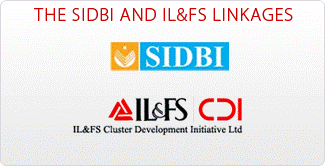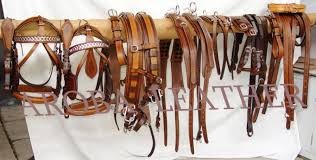Kanpur leather cluster
 The idea of an industrial cluster is that a large number of small manufacturing units located at one place and are together able to produce a final product; while each of them might be involved in only one or a few steps in a complex chain of production. Thus this kind of production system may be seen as a substitute for a large scale corporate production system. Today such clusters are found in various parts of Asia, Europe, Latin America and other parts of the world. In India we hear about dedicated clusters manufacturing textiles in Varanasi, Tirupur, Jaipur, etc., as well as locks & keys in Aligarh, brassware in Moradabad, pumps in Rajkot, bicycles in Ludhiana, leather in Kanpur so on. The author wishes to give hereby an analysis of how Kanpur leather cluster grew.
The idea of an industrial cluster is that a large number of small manufacturing units located at one place and are together able to produce a final product; while each of them might be involved in only one or a few steps in a complex chain of production. Thus this kind of production system may be seen as a substitute for a large scale corporate production system. Today such clusters are found in various parts of Asia, Europe, Latin America and other parts of the world. In India we hear about dedicated clusters manufacturing textiles in Varanasi, Tirupur, Jaipur, etc., as well as locks & keys in Aligarh, brassware in Moradabad, pumps in Rajkot, bicycles in Ludhiana, leather in Kanpur so on. The author wishes to give hereby an analysis of how Kanpur leather cluster grew.
Sectored clusters: When a cluster is formed for businesses operating in the same sector it is called sectored cluster. In India, the Kerala government emphasized that SMEs face multi-dimensional problems in their upward movement, the joint director of industries in Kearala saw the need for strengthening the key issue in helping the small and medium scale businesses in achieving the economies of scale and improving their negotiation power, specialization, access to credit, strategic information, technology, raw material availability and marketing capability. Some of these problems are caused mainly due to isolation of SMEs and hence they decided to form sectoral clusters. Further, the Kerala government has decided to set up an international skill academy to boost the growth of micro, small and medium enterprises (MSME). This was announced recently by the state Labour Minister.
Firms engaged in clustering typically show competitive advantage in four key areas:
Increased productivity in business: Companies operating in a cluster operate more efficiently by taking better advantage of economies of scale and shared resources with other businesses.
Innovation: With help of educational establishments in the cluster, by gathering information from other businesses, sources of more knowledge and experience innovation in technology and business processes becomes very easy.
Knowledge transfer: Due to easy connectivity with other businesses, government’s initiatives in training and development knowledge is easily transferable. New businesses are more benefited.
Market awareness: Clustering allows companies to serve existing markets better and to respond to future market changes, through the establishment of closer links with local clients and markets. Companies in a cluster can also act co-operatively in sourcing market data.
Kanpur is well known global hub of leather industries. There are saddler and equestrian goods exporters, shoe and shoe components manufacturers and exporters as well as producers of finished leather, leather garments and leather accessories. The leather units of Kanpur are renowned for high quality leather products and realistic pricing.
History of this cluster dates back to 150 years ago, when the British set up factories for production of shoes and saddler items to meet military requirements. During World War I, the existing capacity was inadequate to meet the increasing demands. Local entrepreneurs were encouraged to set up manufacturing facilities for these items. World War II further motivated the growth of these industries, and in due course of time Kanpur became a prominent centre of production of leather & leather products.
There are organizations catering specifically to the needs of Indian leather industries viz. Central Leather Research Institute of India, Footwear Design and Development Institute of India and Council of Leather Exports, India etc. and many others. In India, the Kanpur leather cluster has grown substantially over the years. It includes geographical boundaries of district Kanpur (urban) and Unnao town and Banthar leather complex situated in Unnao district. This was necessitated as majority of units are situated in Kanpur city but a few units are also at Unnao and Banthar leather complex.
BDS (Business Development Service) market though fragmented, offers subsidized services which are fixed and packaged. The category of fee based services is in areas of testing, tax & audit, ISO certification & social audit. There are not too many service providers barring CAs. Associations are mainly engaged in advocacy work. In spite of presence of large no of government institutions, linkages with industry are very weak. Dependence of such institutes on subsidy for provision of services has also led to limited outreach. There is also lack of awareness about efficacy of using such services and culture of dependency and availing subsidized and free services prevail.
Facilitating Business Development Service (BDS) market is one of the components of a multi donor assisted project for improving performance and competitiveness of SMEs in India leading to generation of employment and reduction of poverty. SIDBI is its implementing agency and the Department of Banking, Ministry of Finance, GOI is its nodal agency. In the initial phase, SIDBI has selected 3 clusters for such interventions and Kanpur leather cluster is one of such selected clusters.
BDS services in the cluster are being provided by three categories of providers i.e. I) government support institutions, ii) industries associations and iii) private agencies/individuals. There are very few fee based services and mostly are subsidized or embedded/bundled services.
There is plethora of government support institutions providing free/subsidized services. (A) Council of Leather Exports (CLE) CLE is an outfit of Ministry of Commerce & Industry, GOI having regional office at Kanpur. It is a member based organization and its mandate is to provide support to its members for increasing export. At present CLE Kanpur has 349 members and annual membership fee collected by them is Rs 40 lakh. The membership fee is being charged on the basis of export turnover. Major services provided by them are: Dissemination of information regarding exports, organizing trade fares, organizing buyers and sellers meet, marketing assistance, advocacy support regarding concerned ministries
IIT, Kanpur has a separate consultancy department catering to needs of SMEs created for providing services in the areas of energy conservation methods, marketing & finance, innovative product design, packaging, IT applications and application of multimedia. It has also set up an incubation centre with the financial support of SIDBI. This centre provides enabling conditions like provision of incubation space, access to library and venture capitalists and technical assistance to budding entrepreneurs and starts ups undertaking innovative projects. The services are subsidized and in lieu of its services IIT go for equity participation in assisted companies on mutually agreed terms.
International Institute of Saddlery Technology & Export Management (IISTEM):
IISTEM was set up with the assistance of UNDP under its National Leather Development Programme and is functional since 2000. It runs three year Diploma Course in Saddlery Technology and one year courses in footwear manufacturing and design. It also conducts short term courses for operators catering to needs of footwear and saddlery sub sectors. All courses are fee based and IISTEM is getting no grants from the government. In a year they are training about 150 persons at different level needed by saddlery and footwear sub sectors. It has also created one common facilities centre widely used by small manufacturers by paying charges based on time usage of machines. IISTEM with support of IIT, Kanpur has developed design and prototype of polymer tree used by saddlery sub –sector and has also commercialized it and identified one local unit for its manufacturing & marketing. They are receiving royalty to the tune of Rs 1.5 lakh every year.
National Productivity Council (NPC)
NPC is having its regional office at Kanpur. It provides consultancy in major areas like productivity improvement, energy savings and human resources development. It provides all services are fee based. At Kanpur their major clients are PSUs and big units in sugar and manufacturing sector. Due to reluctance of SMEs to pay fees, they are not targeting SMEs and also their presence in leather sector is marginal.
There are many engineering colleges and management institutes running different courses. Though they have wherewithal to provide services to SMEs in various fields but presently providing no such services to SMEs.
 SIDBI and private infrastructure development firm, IL&FS, have jointly taken the initiative to impart training to financial accountants engaged in the local leather industry. The move is aimed at enabling entrepreneurs to make the most of various government sops and schemes by maintaining their financial records proficiently. This is how the Kanpur Leather Cluster has grown in leaps and bounds in India with the initiatives from Government and private players.
SIDBI and private infrastructure development firm, IL&FS, have jointly taken the initiative to impart training to financial accountants engaged in the local leather industry. The move is aimed at enabling entrepreneurs to make the most of various government sops and schemes by maintaining their financial records proficiently. This is how the Kanpur Leather Cluster has grown in leaps and bounds in India with the initiatives from Government and private players.
In some places, nations, regions, cities, the governments or local governments provided tax incentives and other concessions to enable cluster growth. Clusters have created attractive business districts which in turn brought in investments, created more jobs and promoted lesser developed areas. Cluster formations have made lesser developed areas more attractive; they have brought in broader tax bases. Hence many state and central governments in the world have recognized that it is worthwhile, and indeed more economical providing an infrastructure base to a cluster than to provide similar services and infrastructure to disparate firms located far from each other.
At present this cluster has a concentration of units producing semi finished/finished leather/footwear/and saddlery & harness items. In recent times a few units have come up for making leather garments and leather goods also. In addition, Kanpur Cluster also situates many units involved in tanning of leather. In all there are about 1600 units engaged in production of leather & leather products and total volume of business of this cluster is about Rs. 2900 crores.
Existing and Emerging Strengths of Kanpur Cluster
- Design development initiatives by institutions and individuals
- Continuous modernization and technology upgradation
- Economic size of manufacturing units
- Constant human resource development program to enhance productivity
- Increasing use of quality components
- Shorter prototype development time
- Delivery compliance
- Growing domestic market and international demand for footwear and leather articles
Businesses in a cluster provide high levels of support to each other. Clusters may form as large companies attract suppliers and other providers. Kanpur leather cluster is growing steadily and becoming one of the well acclaimed clusters in the world.














































